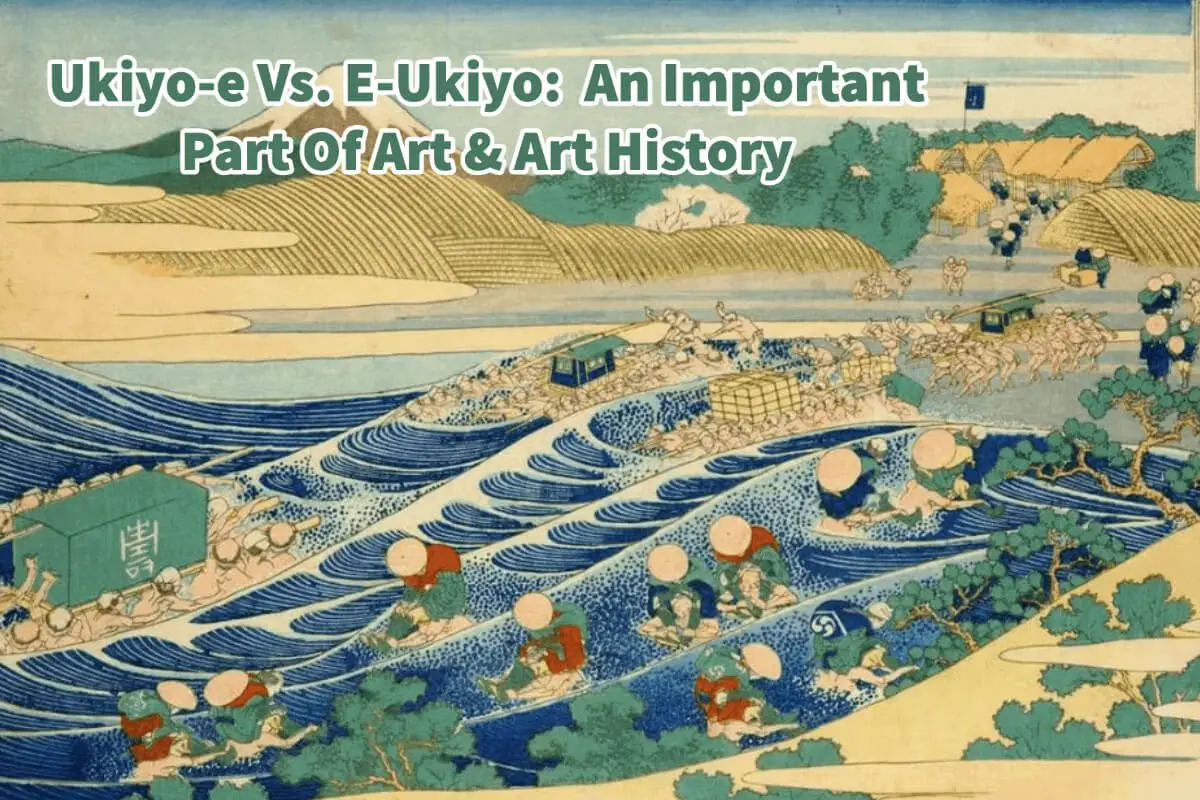One of my favorite Japanese periods of art is the Ukiyo-e period of Japanese art. Ukiyo-e influenced many artists, including me and my art.
Two forms of Japanese art continue to influence Western artists: the Ukiyo-e art and E-Ukiyo. Both of these are unique Japanese art forms. The Ukiyo-e is the art form that emerged in the 17th century. The E-Ukiyo is a more modern art form associated with digital art.
Table of Contents
- The Definition Of Ukiyo-e And The Floating World
- The Modern E-Ukiyo Art Defined
- Uikyo-e And E-Ukiyo Explained
- Frequently Asked Questions
- Related Questions
The Definition Of Ukiyo-e And The Floating World
Ukiyo-e is a Japanese art form that emerged in the 17th century during the Edo period. Ukiyo means “floating world” in Japanese, and it refers to the world of pleasure, entertainment, and leisure that was popular among the urban middle class during the Edo period.
Ukiyo-e is a type of woodblock print that depicts scenes from the floating world, such as kabuki actors, courtesans, landscapes, and animals. The Japanese art form influenced many great Western artists, including Claude Monet and Vincent Van Gogh.
The Modern E-Ukiyo Art Defined
E-Ukiyo is a modern form of Ukiyo-e that has emerged in recent years. The “E” in E-Ukiyo stands for “electronic,” which refers to using digital technology to create Ukiyo-e prints.

This is one of the examples of E-Ukiyo modern paintings.
E-Ukiyo artists use digital tools such as tablets, software, and printers to create artworks, often inspired by traditional Ukiyo-e themes and motifs. Even programs such as Photoshop and Procreate are being used.
The idea of E-Ukiyo is to use modern technology to revive the ancient art form of Ukiyo.
Uikyo-e And E-Ukiyo Explained
Ukiyo-e and E-Ukiyo are essential parts of art and history for several reasons. Here are some of the primary reasons:
Ukiyo-e and E-Ukiyo Are Japanese Art Form
Ukiyo-e and E-Ukiyo are significant examples of Japanese art and culture. The Ukiyo-e offers a glimpse into the Edo period’s daily life, customs, and values.
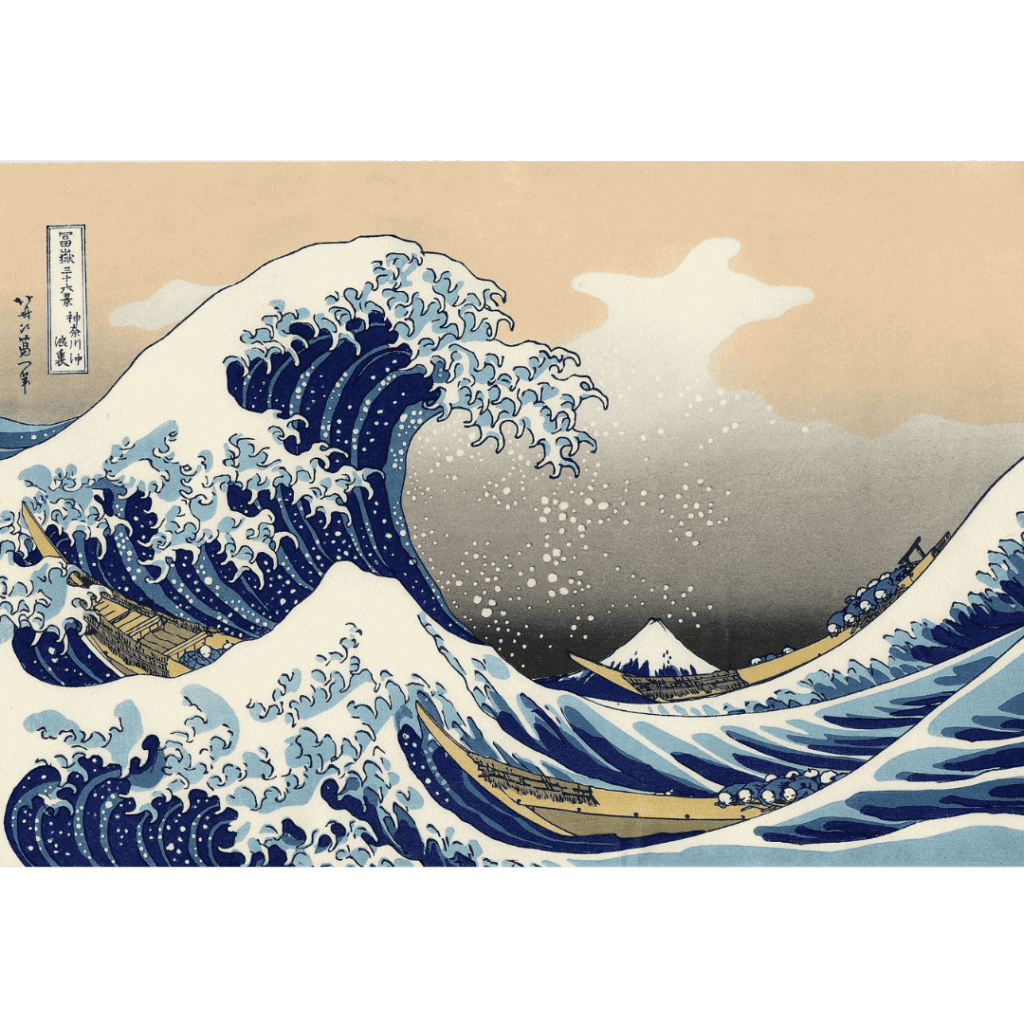
This is one of the famous Ukiyo-e paintings.
Ukiyo-e prints were mass-produced and widely circulated, which made them accessible to a large audience and helped to shape popular culture at the time.
Similarly, E-Ukiyo prints are easily shareable on social media and the internet, which allows them to reach a global audience and contribute to the ongoing evolution of Ukiyo-e as an art form.
Ukiyo-e And E-Ukiyo Has Influenced Western Art
Ukiyo-e and E-Ukiyo have had a significant influence on Western art and artists. During the 19th century, Ukiyo-e prints were imported to Europe and the United States, where they inspired many artists, including Vincent van Gogh, Claude Monet, and Edgar Degas.
Even the American Architect Frank Lloyd Wright was known to collect and also be influenced by the Japanese Ukiyo-e woodblock prints.
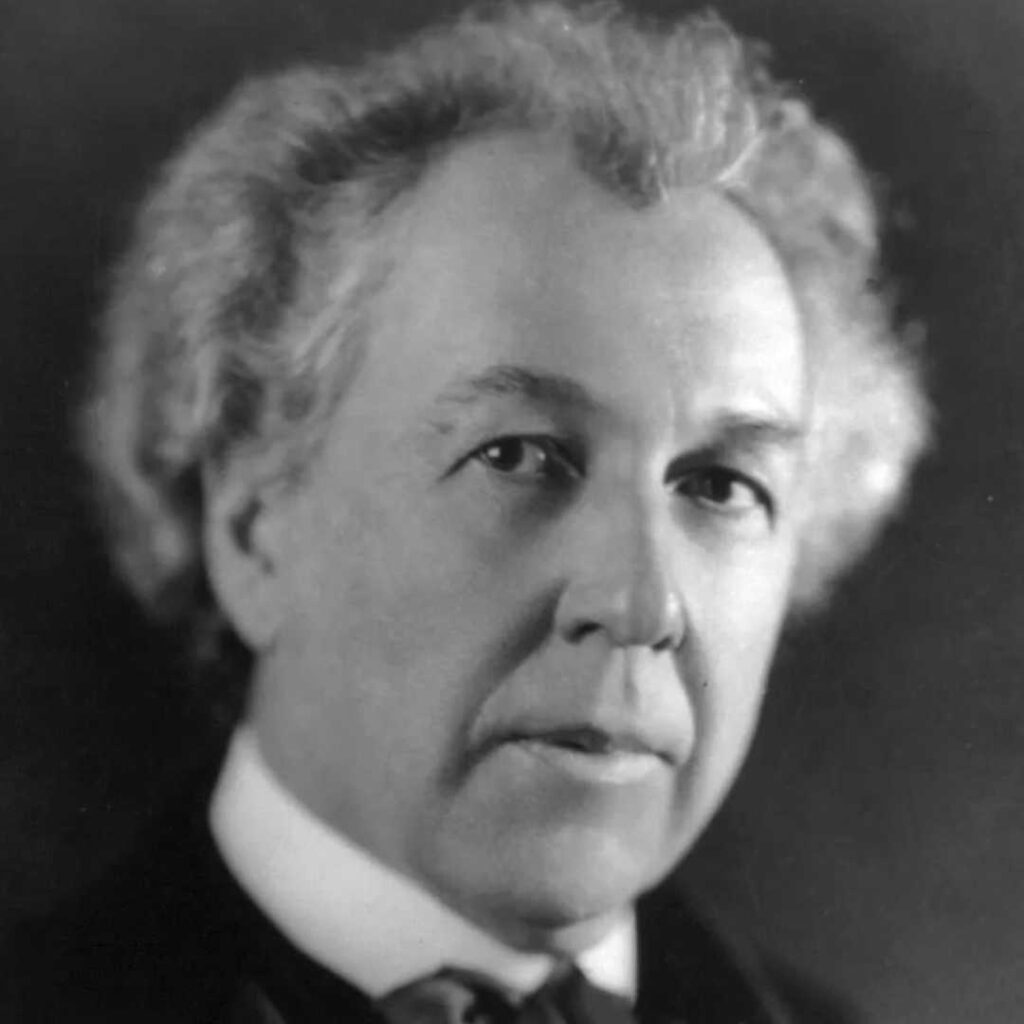
The use of flat, bold colors, asymmetrical compositions, and unconventional perspectives influenced these artists. The Ukiyo-e prints were, therefore, particularly influential in developing modern art movements such as Impressionism and Post-Impressionism.
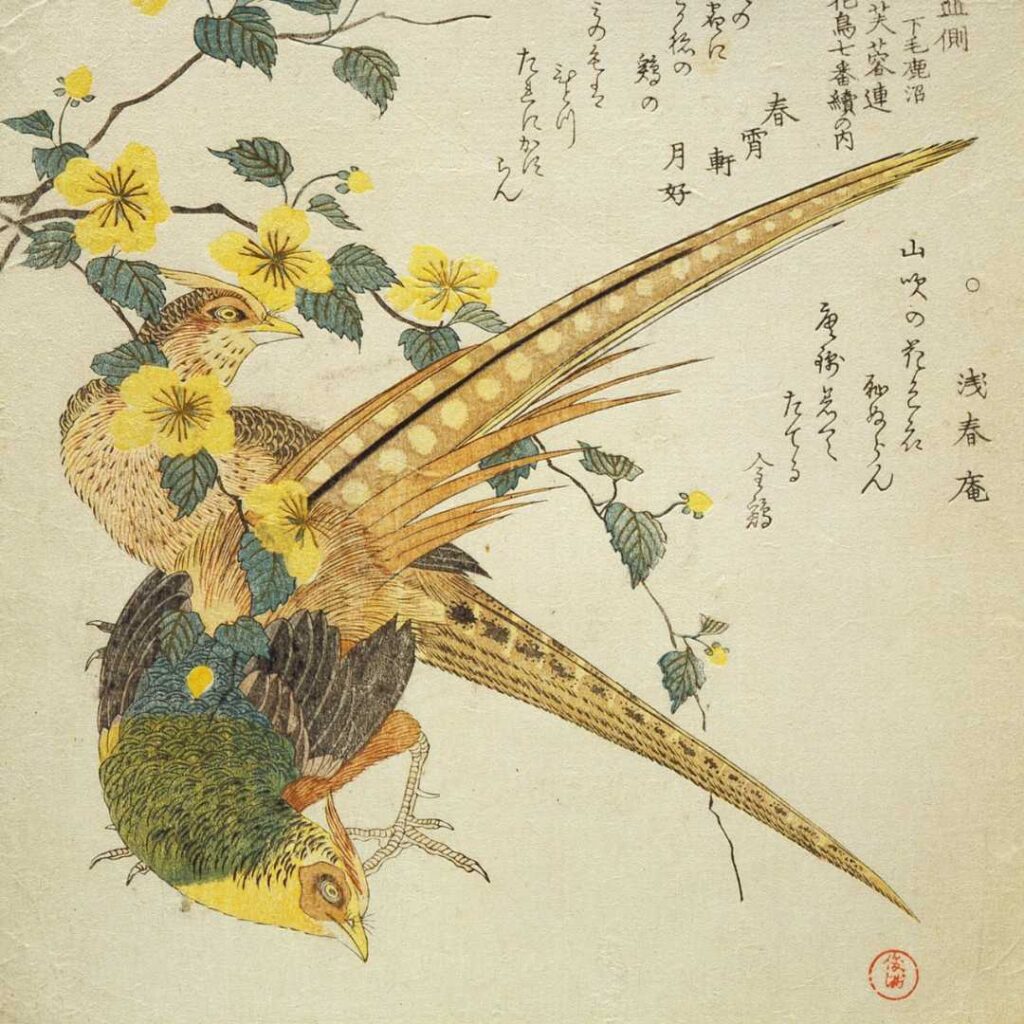
This is one of the Ukiyo-e collections of Frank Lloyd Wright
Today, E-Ukiyo prints continue to inspire and influence artists from around the world, who are drawn to the vibrant colors, bold lines, and graphic style of Ukiyo-e.
Ukiyo-e And E-Ukiyo Give A Unique Approach To Western Art
Ukiyo-e and E-Ukiyo are essential for artists to understand because they represent a unique approach to image-making that challenges traditional Western concepts of art and beauty. Ukiyo-e prints were often created collaboratively by artists, publishers, and printers, who each contributed their skills and expertise to the final product.
One of the exciting parts of the Ukiyo-e woodblock prints is that they helped to set up the kinds of printing collaborations we have today. An artist may produce the art, and others will help print and distribute the works. This influence, workflow, and collaboration are still seen in the market today.
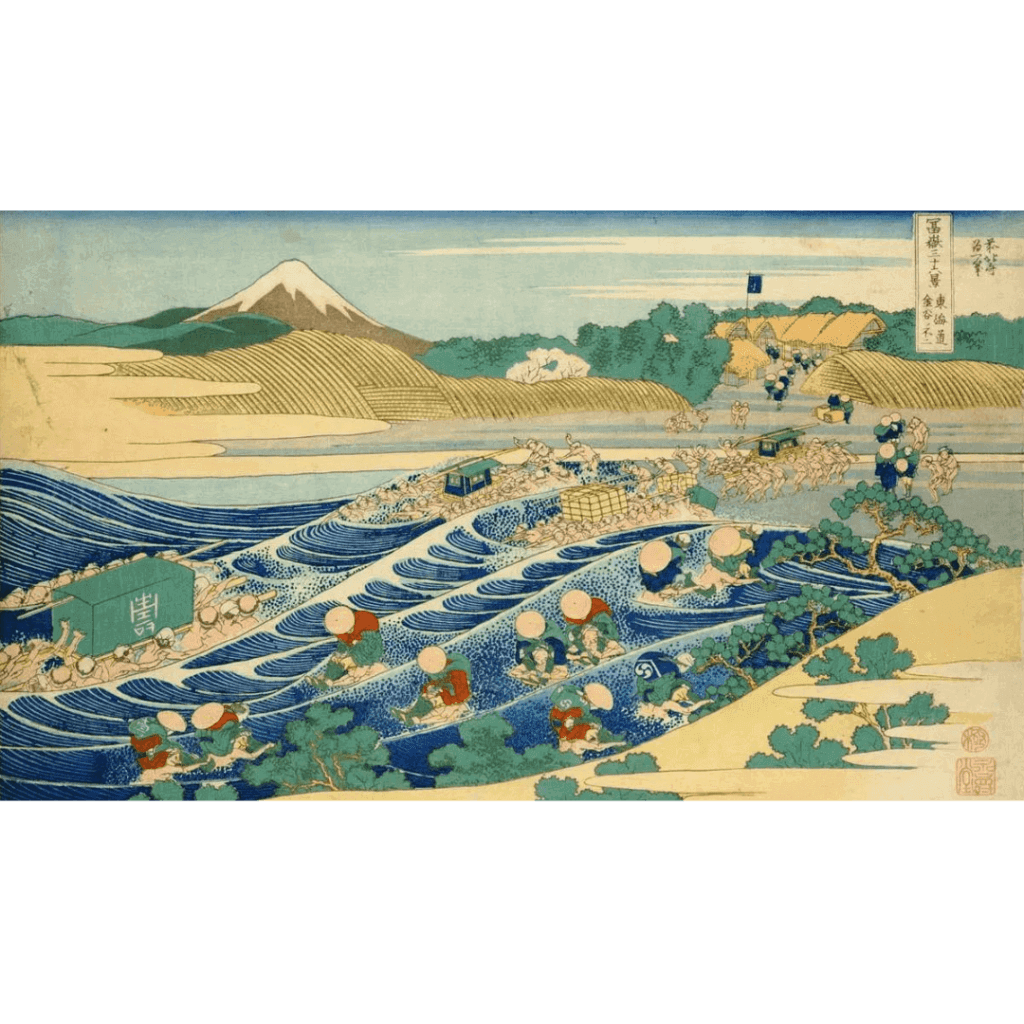
via The British Museum, London
Ukiyo-e had an Emphasis On Commercialization
The Ukiyo-e emphasis was not on individual expression or originality but on creating a visually striking and commercially viable image that would appeal to a broad audience. The artists would produce art that they knew would be able to reach a wider audience and be able to be sold commercially.
The commercial aspect was necessary because of the collaborative nature of the Ukiyo-e prints. A collaborative and commercial approach to art-making was very different from the Romantic and Realist traditions that dominated Western art at the time.
E-Ukiyo Artist Experimented With New Techniques and Challenges Boundaries
Similarly, E-Ukiyo artists often incorporate elements of traditional Ukiyo-e prints into their digital artworks. Still, they also experiment with new techniques and styles that reflect the possibilities of digital media. Using digital tools allows E-Ukiyo artists to create complex and detailed images that would be difficult or impossible to achieve using traditional Ukiyo-e methods.
This hybrid approach to image-making challenges the boundaries between traditional and digital art and raises questions about the nature of authorship, originality, and authenticity in contemporary art.
Today, Ukiyo-e and E-Ukiuo continue to be crucial Japanese art forms. E-Ukiyo and Ukiyo are essential parts of art and art history that offer unique insights into Japanese culture and have significantly influenced Western art.
Anita Louise Art is dedicated to art education, great artists, and inspiring others to find and create their art. We love art that uplifts and inspires. #ArtToMakeYouSmile! #ArtToMakeYouHappy!
If you want to see any of my art, you can find out more by clicking here. If you are interested in what inspires me and my paintings, you can discover more by clicking here.
We have a free newsletter and would love you to be part of our community; you can subscribe to the newsletter by clicking here. I would be happy to talk to you if you have any questions. You can reach me, Anita, by clicking here.
Subscribe to our Anita Louise Art YouTube Channel filled with great videos and information by clicking here.
Join us for our podcast “5 Minutes With Art.” Spend just 5 minutes a week with us to discover and learn about great art and artists. You can find out more about our podcast by clicking here.
Frequently Asked Questions
What is Ukiyo-e, and how did it emerge in the 17th century?
Ukiyo-e refers to a genre of traditional Japanese woodblock prints that originated in the 17th century. This art form primarily depicted scenes from the “floating world,” capturing the transient nature of life during the Edo period. Learn about its historical roots and cultural significance.
How did Ukiyo-e influence artists during its original period and beyond?
Explore the impact of Ukiyo-e on Japanese artists during the Edo period and its lasting influence on Western artists, including its role in shaping the broader art movement known as Japonism.
What distinguishes E-Ukiyo from traditional Ukiyo-e art?
Delve into the characteristics that set E-Ukiyo apart from its traditional counterpart. Explore the technological and stylistic shifts that define this modern form of Japanese art, especially its association with digital media.
How has Ukiyo-e inspired contemporary Western artists?
Discover how Ukiyo-e continues to resonate with contemporary Western artists, influencing their styles, techniques, and thematic choices.
What technological advancements contributed to the evolution of E-Ukiyo art?
Understand the role of technology in the development of E-Ukiyo, especially the influence of digital tools on creating and disseminating art.
Can you provide examples of famous Ukiyo-e prints and E-Ukiyo artworks?
Explore renowned pieces from both Ukiyo-e and E-Ukiyo, showcasing the diversity and evolution of these Japanese art forms.
How did Ukiyo-e reflect the cultural and societal changes during the Edo period?
Gain insights into how Ukiyo-e served as a mirror to the social and cultural dynamics of the Edo period in Japan, capturing the essence of urban life, entertainment, and fashion.
In what ways does E-Ukiyo engage with contemporary themes and issues?
Examine how E-Ukiyo artists address contemporary themes, reflecting the changing landscape of Japanese society and its global connections.
How do traditional and modern Japanese art forms coexist in the contemporary art scene?
Explore the intersection of traditional Ukiyo-e and modern E-Ukiyo within the broader context of the contemporary art world, considering the ongoing dialogue between these two distinct forms.
Related Questions
Characteristics of Japanese Ukiyo-e Woodblock Prints
Japanese woodblock prints were produced to have a mass appeal to the Japanese audience. There are a lot of characteristics in the Japanese woodblock print, such as the asymmetry of design, how the artist experiment with composition, the artist’s use of flats spaces, and the use of colors.
By clicking here, you can learn more by reading Characteristics of Japanese Ukiyo-e Woodblock Printsach Other?.
What Are Some Japanese Woodblock Print Characteristics?
There are many characteristics of a Japanese woodblock print, from the woodblock print title, artist name, and publisher’s seal; other features also include the color and subject matter. Japanese woodblock prints also have different artistic art movements.
By clicking here, you can learn more by reading What Are Some Japanese Woodblock Print Characteristics?.
What Is A Japanese Woodblock Print?
A Japanese woodblock print is, as the name implies, a print that is made by using carved woodblock and applying ink on the woodblocks to print a design on paper. The Japanese woodblock artists used woodblocks to print artistic prints and even books. Artists have used the woodblock print technique in Japan for hundreds of years.
You can learn more by reading What Is A Japanese Woodblock Print? by clicking here.

